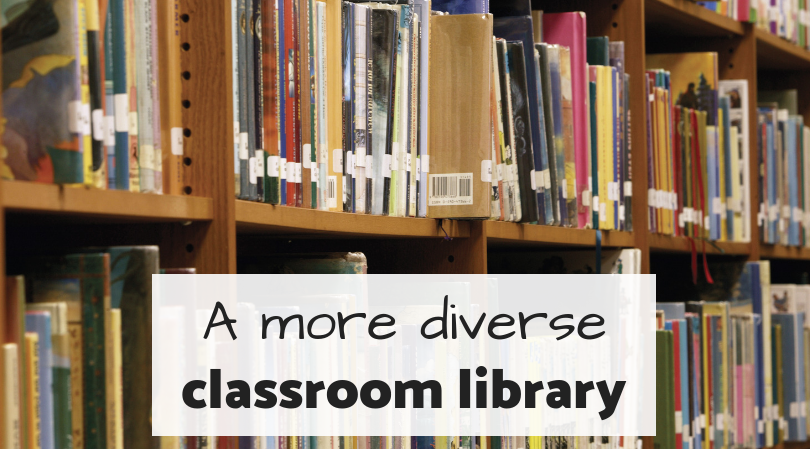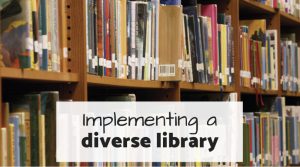How do we select the right book to teach SEL skills, competencies, and values that will guide our students through academic, social, and emotional development and challenges? While no one text can or should do it all, how can we be strategic in building a collection of books and read-alouds that explore your school’s SEL framework?
Continue readingTag Archives: classroom libraries
Finding the Best Diverse Books for Your Classroom

In this guest post originally posted at Achieve the Core, Jill Eisenberg, our Director of Curriculum & Literacy Strategy, shares resources and guidance for teachers on finding high-quality diverse texts and bringing them into the classroom.
If you were asked to sum up your classroom library or read aloud collection with five adjectives, what would you say? Would the word “diverse” make the list?
Our classroom library bookshelves and mentor texts should feel intentional, purposeful, and transforming; to that end, many educators and administrators are eager to infuse more culturally responsive, multicultural, and inclusive stories into the classroom. It can be overwhelming to figure out where to begin with this process, however. As Director of Curriculum & Literacy Strategy at Lee & Low Books, I step into schools and districts to advise on the key components of a culturally responsive book collection and action steps required to evaluate current collections for equity, diversity, and inclusion.
Whether you survey your collection in grade-level teams, with parent volunteers, or on your own, this blog post will share some of the best resources and strategies we at Lee & Low Books have seen over the past thirty years from schools and districts across the nation. Continue reading
Tackling the Challenges of Implementing Diverse Libraries at Your School
New year, new goals! If one of your professional goals this year is to add more diversity to your school or classroom library, we’re here with some inspiration to get you started. In the following blog post, originally posted at the Center for the Collaborative Classroom and cross-posted with permission, our Director of Curriculum and Literacy Strategy Jill Eisenberg shares tips and suggestions for how to move forward without becoming overwhelmed:
How to Build a More Diverse Classroom Library

New year, new goals! If one of your professional goals this year is to add more diversity to your school or classroom library, we’re here with some inspiration to get you started. In the following blog post, originally posted at the Center for the Collaborative Classroom and cross-posted with permission, our Director of Curriculum and Literacy Strategy Jill Eisenberg shares tips and suggestions for how to move forward without becoming overwhelmed: Continue reading
Bebop Books: Guided Reading Book Sets for the Classroom
Bebop Books is an exclusive imprint of LEE & LOW BOOKS that offers leveled books for guided reading and assessment in the classroom—all with the same commitment to diversity and cultural authenticity that sets all LEE & LOW books apart. In this blog post, we want to spotlight this special imprint and all it offers.
In 2014, children of color became the new majority in America’s public schools, so now more than ever, it’s important that classroom books and materials reflect today’s students. Our Bebop Books resources are used in classrooms across the country to support literacy learning content for beginning readers, with multicultural content that affirms identity for all students. Continue reading
Books as Bricks: Building a Diverse Classroom Library and Beyond
Last week, Tu Books Publisher Stacy Whitman spoke at the Kansas Association of Teachers of English (KATE) conference about why and how to use diverse books in the classroom. In this blog post, we share some highlights from her presentation that may be helpful for readers across the country. Continue reading
Author Rosanne Parry on the Benefits of Reading Levels
The topic of reading levels is always contentious fo![]() r librarians, educators, booksellers, and authors. A recent article by author Sergio Ruzzier argued against the merits of using reading levels to determine which book is right for a child. In this guest post, author and bookseller Rosanne Parry offers her thoughts on why reading levels can be valuable, despite some of the drawbacks. Welcome, Rosanne! Continue reading
r librarians, educators, booksellers, and authors. A recent article by author Sergio Ruzzier argued against the merits of using reading levels to determine which book is right for a child. In this guest post, author and bookseller Rosanne Parry offers her thoughts on why reading levels can be valuable, despite some of the drawbacks. Welcome, Rosanne! Continue reading
Books for Holidays: MLK Day, Chinese New Year, and More
 Jill Eisenberg, our Resident Literacy Expert, began her career teaching English as a Foreign Language to second through sixth graders in Yilan, Taiwan as a Fulbright Fellow. She went on to become a literacy teacher for third grade in San Jose, CA as a Teach for America corps member. She is certified in Project Glad instruction to promote English language acquisition and academic achievement. In her column she offers teaching and literacy tips for educators.
Jill Eisenberg, our Resident Literacy Expert, began her career teaching English as a Foreign Language to second through sixth graders in Yilan, Taiwan as a Fulbright Fellow. She went on to become a literacy teacher for third grade in San Jose, CA as a Teach for America corps member. She is certified in Project Glad instruction to promote English language acquisition and academic achievement. In her column she offers teaching and literacy tips for educators.
We’re in the process of updating our lists of recommended books for special holidays! Our diverse books cover a wide range of holidays, celebrations, and important moments in history. Whether you are looking to rejuvenate your holiday read alouds in the classroom or purchase a gift to remember a special moment, you’ll find the perfect title on our list. Here’s what we’re celebrating – and reading – in January:
JANUARY 20
Martin Luther King, Jr.’s Birthday
The Bus Ride
A More Diverse Appendix B
Please find our most updated post, “A More Diverse Appendix B” here.
In this blog post, Resident Literacy Expert Jaclyn DeForge shares a multicultural supplement to the Common Core’s Appendix B list.
When the Common Core Standards were created, the authors included a list of titles in Appendix B that exemplified the level of text complexity (found in Appendix A) and inherent quality for reading materials at each grade level. This list was intended as a comparative tool, as a way for teachers and administrators to measure current libraries against country-wide expectations for rigorous literature and informational text. Since its publication, this list, and the titles included and omitted, have created quite a bit of controversy.


